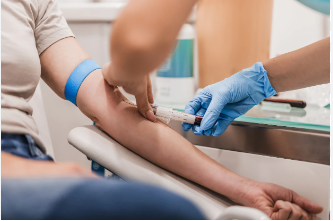A novel method for a common blood test may be able to estimate an individual’s 30-year risk of heart disease, according to research that was just published in the New England Journal of Medicine on Saturday.
For a long time, doctors have used a blood test to measure cholesterol levels and determine their patients’ risk for cardiovascular disease.
They pay special attention to low-density lipoprotein, or “bad” cholesterol. However, experts claim that restricting blood testing to only measure cholesterol ignores significant risk variables, most of which are silent.

“We possess additional biomarkers that inform us about different biological issues our patients who are predisposed to cardiovascular disease are probably going to have,” stated Dr. Paul Ridker, the primary study author and director of Brigham and Women’s Hospital in Boston’s Center for Cardiovascular Disease Prevention.
Apart from low-density lipoprotein (LDL) cholesterol, Ridker and colleagues discovered that two additional blood markers—lipoprotein (a), or Lp(a)—and an inflammatory marker are significant predictors of an individual’s risk of heart attack, stroke, and coronary heart disease.
Additionally, the results were presented on Saturday in London at the European Society of Cardiology Congress 2024.
Researchers examined information from about 30,000 American women who took part in the Women’s Health Study for this study. When the ladies entered from 1992 to 1995, they were, on average, 55 years old. During the course of the 30-year follow-up period, around 13% of the participants, or about 3,600 people, experienced a heart attack or stroke, underwent surgery to open a narrowed or blocked artery, or passed away from heart disease.
Although the study was conducted on women, Ridker predicted that males would also likely benefit from the findings.

However, he said that the emphasis on women was deliberate. “This is a disease that can be prevented in large part, but women are often underdiagnosed and undertreated.”
Before the trial started, all of the women had blood tests done to determine their levels of LDL cholesterol, Lp(a), and C-reactive protein, which is a sign of inflammation in the body.
The study discovered that these parameters, both alone and collectively, seemed to predict a woman’s heart health over the ensuing thirty years.
Compared to women with the lowest levels of LDL cholesterol, those with the highest levels had a 36% increased risk of heart disease. The highest CRP levels were associated with a 70% increased risk of heart disease, while the highest Lp(a) levels showed a 33% heightened risk.
When the three were combined, women with the highest levels were nearly three times more likely to develop coronary heart disease and 1.5 times more likely to have a stroke over the following 30 years than those with the lowest levels.
A increased risk of heart disease has been associated with each sign separately, although “all three represent different biological processes.” They explain to us why a person is genuinely in danger,” Ridker remarked.
Getting involved early
Conventional heart disease risk factors include high blood pressure, high cholesterol, diabetes, and obesity. Lp(a) and CRP testing can identify less evident risk factors.
“Having a high Lp(a) alone puts you at risk even if you don’t have any traditional risk factors,” stated Dr. Rachel Bond, the system director of women’s heart health at Dignity Health in Arizona, who was not involved in the study.
Everyone should get a Lp(a) test at least once throughout their lifetime, according to Bond. They will always have high levels if they do at any time. One warning, though: according to Bond, post-menopausal women may experience elevated Lp(a) and may wish to have their levels checked once again at that point.
Conversely, a person’s levels of LDL cholesterol and CRP change during the course of their lifetime. In order to identify possibly missed risk factors early on, while there is still time to take action, Ridker encourages doctors to do the three-pronged blood test on patients who are in their 30s or 40s.
While healthy lifestyle choices like exercise, diet, and quitting smoking are important, people who already have elevated levels of Lp(a), LDL, and CRP will probably need to take medication, according to Dr. Steven Nissen, chief academic officer of the Cleveland Clinic’s Heart, Vascular, and Thoracic Institute and person who was not involved in the study.
According to Nissen, “we can’t expect lifestyle interventions to do the job alone for the majority of people.”
Future research may address the study’s various flaws, one of them being the absence of racial and ethnic variety, which is a significant factor in an individual’s risk for heart disease. 94% of the participants were white or less.
Nissen said that when Lp(a) levels above a particular point, the research no longer measured them.
“The clinical threshold at which a patient would be treated was not even reached by the highest levels of lipoprotein (a) in this study,” he stated. “It frequently underestimates lipoprotein (a) risk.”
Heart disease expert Dr. Kunihiro Matsushita, an epidemiology professor at the Johns Hopkins Bloomberg School of Public Health, stated that although inflammation is undoubtedly significant, “that doesn’t mean CRP is the best marker for predicting cardiovascular disease risk.”
Not engaged in the current research, Matsushita added, “Using three biomarkers is interesting, but the choice of which biomarkers these are can be explored further.”
He continued by saying that testing for inflammation, low-density lipoprotein (LDL), and lipoprotein (a) is especially crucial for individuals who are often seen as having a low risk of heart disease, such as women, young people, and persons of East Asian heritage.






